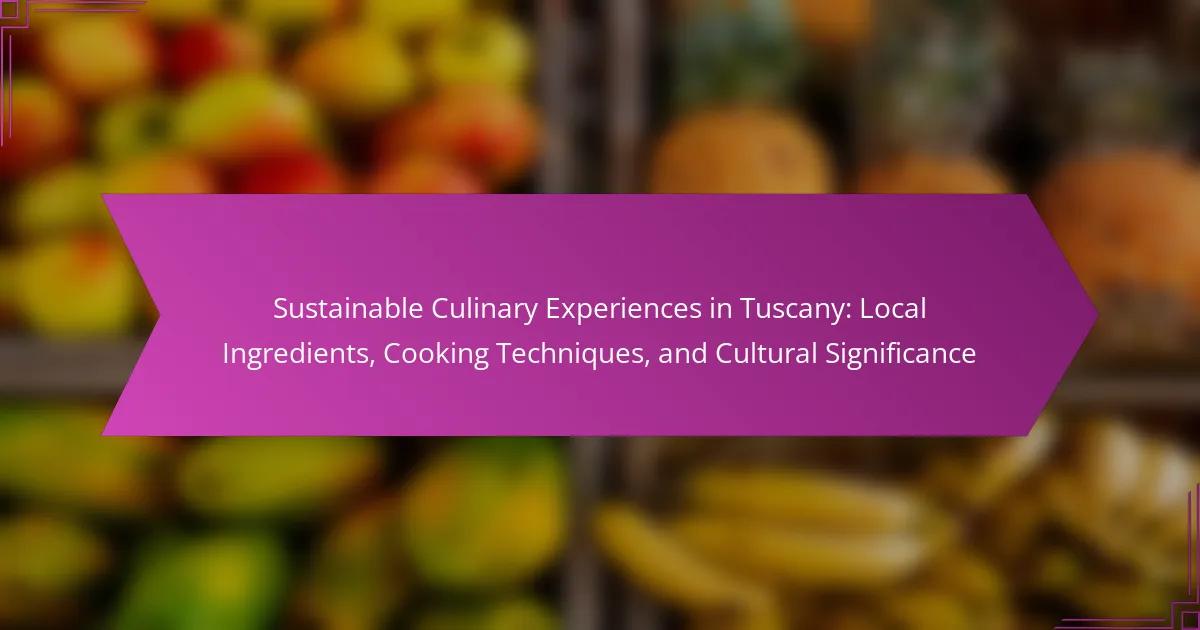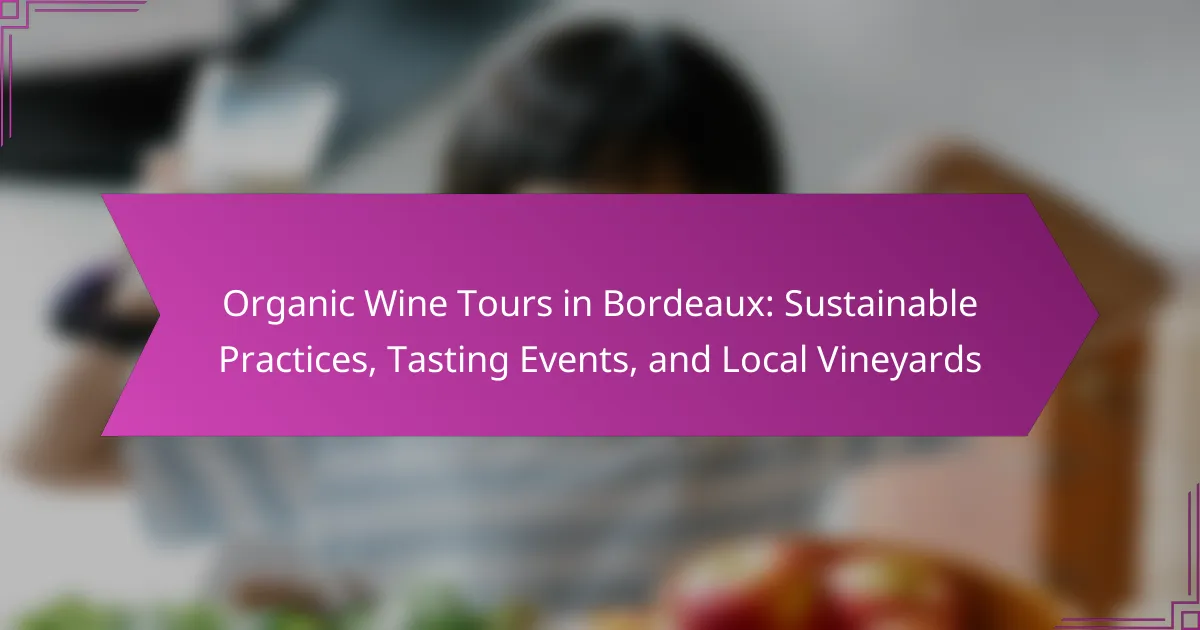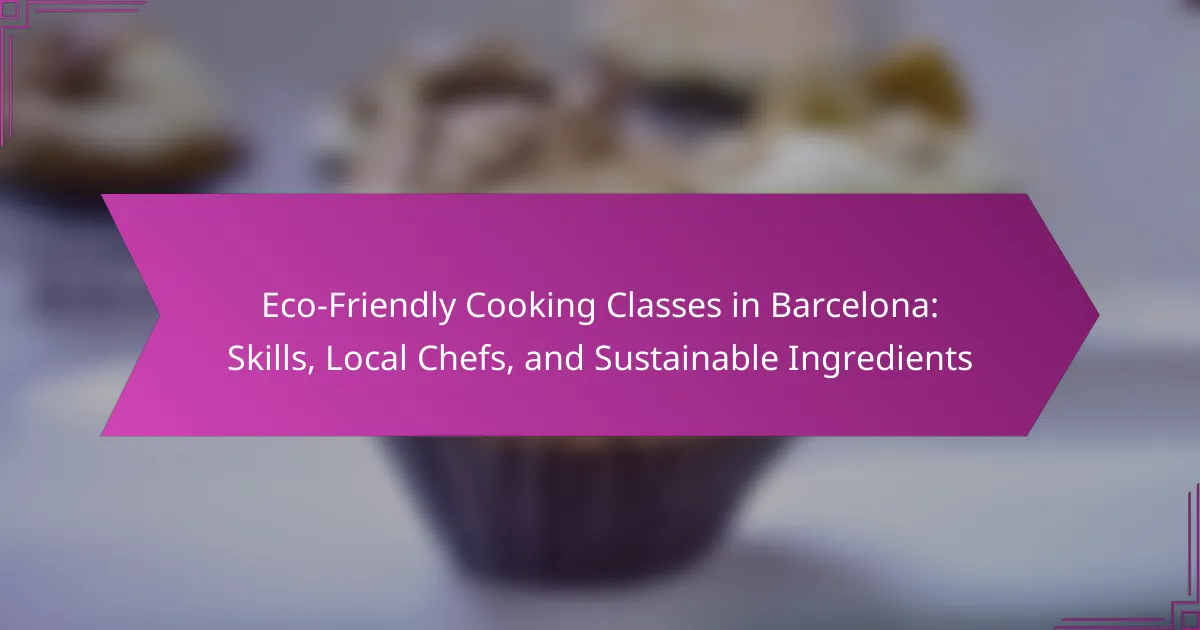Culinary festivals in Italy offer a unique opportunity to experience regional dishes, cultural traditions, and community involvement. Highlights include the Festa della Pizza in Naples, Sagra del Tartufo in Alba, and VinItaly in Verona. These events not only celebrate local ingredients but also strengthen community ties and promote sustainability. Engaging local chefs and artisans, they create authentic experiences that preserve Italy’s rich culinary heritage.
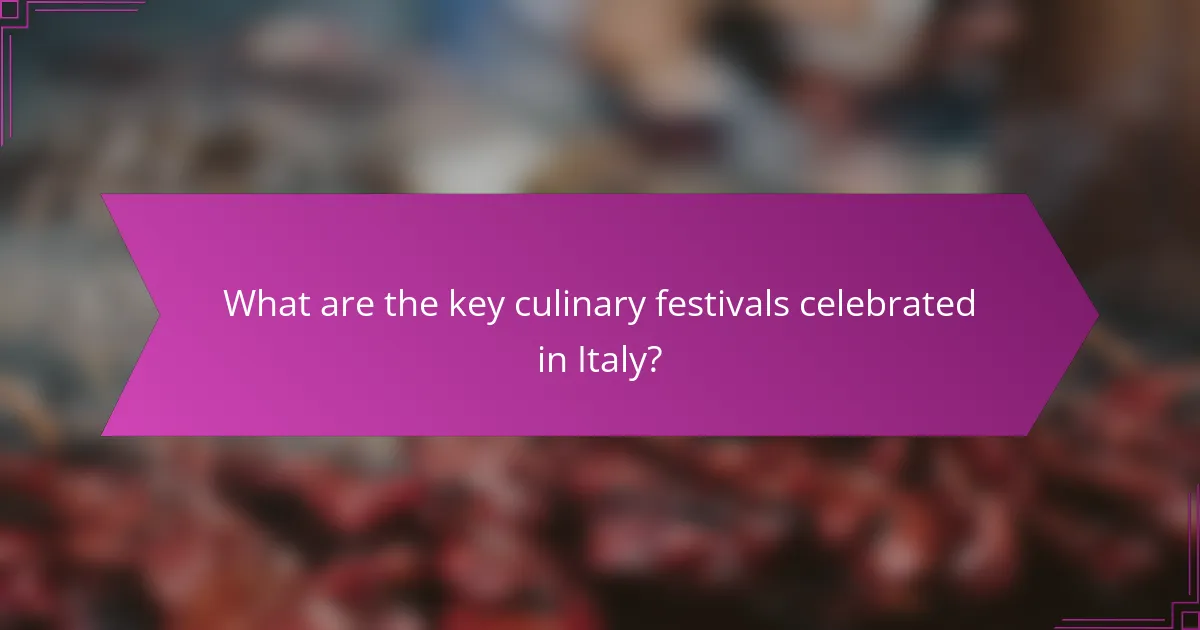
What are the key culinary festivals celebrated in Italy?
Italy celebrates numerous culinary festivals that showcase unique dishes, cultural traditions, and community involvement. Notable festivals include:
1. Festa della Pizza in Naples, focusing on authentic Neapolitan pizza.
2. Sagra del Tartufo in Alba, dedicated to truffles and local cuisine.
3. VinItaly in Verona, celebrating Italian wines and regional pairings.
4. Sagra della Porchetta in Ariccia, highlighting traditional roasted pork.
5. Fiera del Cibo in Bologna, featuring diverse regional foods and local artisans.
These festivals enhance community ties while preserving culinary heritage.
How do regional specialties influence festival offerings?
Regional specialties significantly shape festival offerings in Italy by highlighting local ingredients and culinary traditions. Each region showcases unique dishes that reflect its cultural heritage. For instance, the Emilia-Romagna region is renowned for its pasta, such as tortellini, while Sicily features arancini. Festivals often celebrate these local delicacies, fostering community involvement and preserving traditions. Additionally, regional variations in recipes and cooking techniques enhance the diversity of culinary festivals, making them vibrant reflections of Italy’s rich gastronomic landscape.
Which festivals highlight unique traditional dishes?
Culinary festivals in Italy showcase unique traditional dishes that reflect regional cultures and community involvement. Events like the Sagra del Tartufo in Umbria highlight truffle dishes, while the Festa della Cipolla in Tropea celebrates onion-based recipes. The Palio di Siena features traditional Tuscan fare, and the Carnevale di Venezia offers unique Venetian seafood dishes. Each festival emphasizes local ingredients and culinary heritage, fostering community pride and participation.
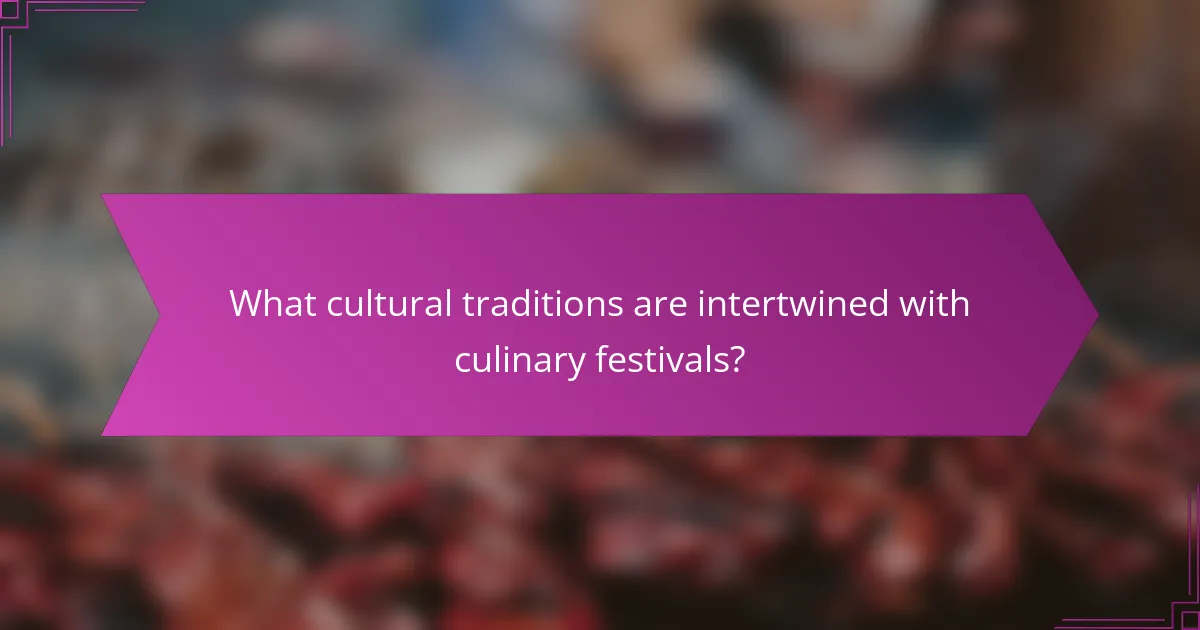
What cultural traditions are intertwined with culinary festivals?
Culinary festivals in Italy are deeply intertwined with cultural traditions, showcasing regional heritage and community spirit. These festivals celebrate local ingredients and traditional recipes, often linked to historical events or agricultural cycles. For example, the Sagra della Porchetta highlights the importance of pork in Italian cuisine, while the Festa della Vendemmia honors the grape harvest. Community involvement is essential, as locals participate in cooking, organizing events, and preserving culinary arts. This blend of food, culture, and community fosters a strong sense of identity and pride among participants.
How do local customs shape the festival experience?
Local customs significantly enhance the festival experience by fostering community connections and showcasing regional culinary traditions. Each Italian culinary festival reflects local ingredients and cooking techniques, creating unique dishes that resonate with cultural heritage. For instance, the Sagra del Tartufo in Umbria celebrates truffles, highlighting their importance in local cuisine. Additionally, community involvement is vital; locals often participate in preparations and serve dishes, deepening the sense of belonging. This blend of tradition, food, and community engagement creates a vibrant atmosphere, making each festival a unique celebration of local identity.
What role does music and dance play in these celebrations?
Music and dance are integral to culinary festivals in Italy, enhancing the celebratory atmosphere. They foster community spirit and cultural expression, showcasing regional traditions. For example, folk dances often accompany traditional dishes, creating a lively experience that connects attendees to their heritage. Additionally, live music performances elevate the enjoyment of unique culinary offerings, making these festivals memorable events.
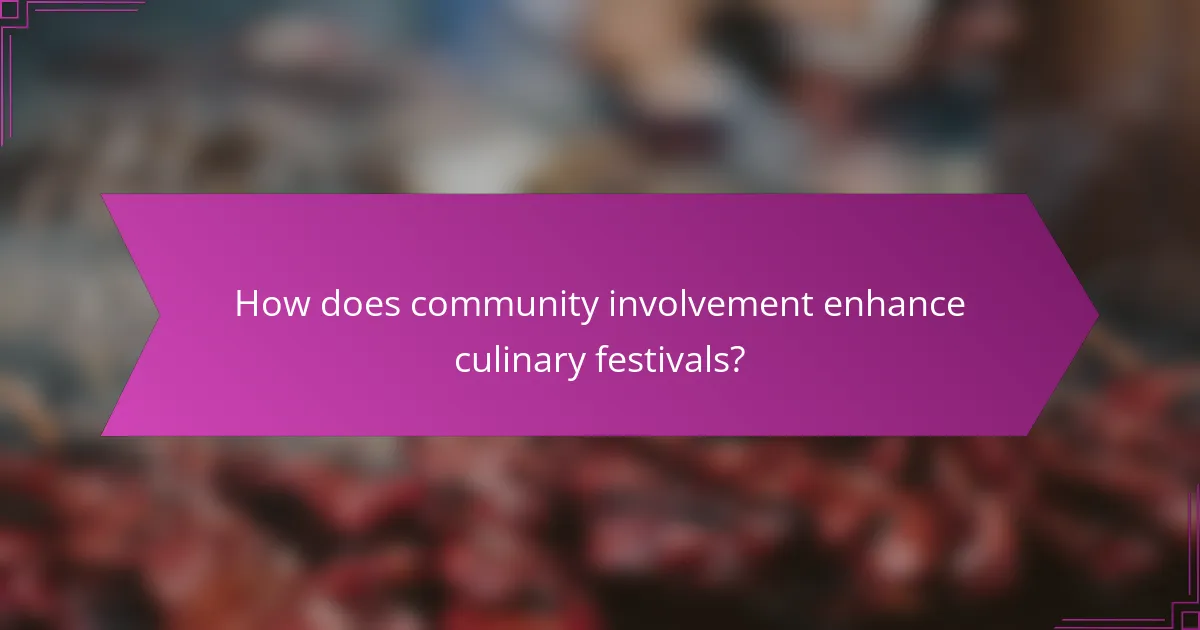
How does community involvement enhance culinary festivals?
Community involvement significantly enhances culinary festivals by fostering local pride and cultural exchange. Engaging local chefs, farmers, and artisans creates authentic experiences that showcase unique regional dishes. This collaboration strengthens community ties and promotes traditional culinary practices. Additionally, volunteer participation enriches the festival atmosphere, encouraging a sense of belonging among attendees. As a result, culinary festivals become vibrant celebrations of heritage, attracting both locals and tourists.
What are the benefits of local participation in festival activities?
Local participation in festival activities enhances community bonds and promotes cultural heritage. Engaging residents fosters pride in unique culinary traditions. It also stimulates local economies through increased foot traffic and sales. Furthermore, collaboration among locals encourages the sharing of diverse skills and knowledge, enriching the overall festival experience.
How do festivals foster community spirit and identity?
Culinary festivals in Italy foster community spirit and identity through shared experiences, local traditions, and collaborative activities. These events celebrate regional dishes, bringing together residents and visitors alike.
Participants engage in cooking demonstrations, tastings, and workshops, reinforcing cultural pride. Unique dishes, such as risotto from Lombardy and pasta from Emilia-Romagna, showcase local ingredients and culinary techniques.
As a result, these festivals strengthen community bonds, promote local economies, and encourage cultural exchange. They also create lasting memories and connections among attendees, enhancing the sense of belonging.
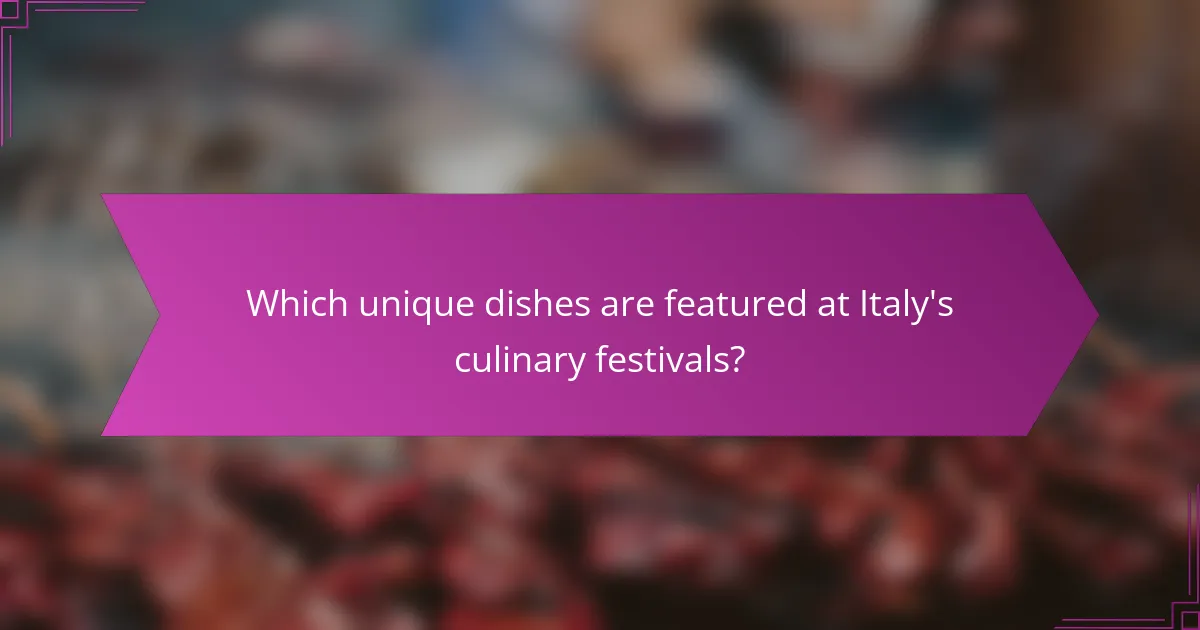
Which unique dishes are featured at Italy’s culinary festivals?
Italy’s culinary festivals showcase unique dishes that reflect regional flavors and traditions. Notable examples include Arancini at the Sagra del Riso in Lombardy, which highlights rice balls stuffed with various fillings. The Palio di Siena features Pici, a hand-rolled pasta served with rich sauces. In Umbria, the Festa della Tonna celebrates Tonnarelli, a traditional egg pasta known for its distinct texture. The Sagra della Porchetta in Lazio is famous for its succulent roasted pork, served with aromatic herbs. Each festival emphasizes local ingredients and community involvement, enriching Italy’s culinary landscape.
How do seasonal ingredients influence festival menus?
Seasonal ingredients significantly shape festival menus in Italy, enhancing authenticity and flavor. Each festival showcases local produce, emphasizing regional culinary traditions. For instance, truffles in autumn festivals highlight the unique flavor profile of the region. Seasonal variations ensure dishes reflect the time of year, promoting community involvement and appreciation for local agriculture. Festivals foster connections between chefs and farmers, creating a vibrant culinary landscape.
What are the most iconic dishes associated with specific festivals?
Italy’s culinary festivals showcase iconic dishes that reflect regional traditions and seasonal ingredients. Notable examples include the Sagra dell’Uva in Tuscany, featuring grape-based dishes, and the Festa della Polenta in Veneto, celebrating polenta with various toppings. The Palio di Siena highlights traditional Tuscan fare, while the Festa di San Giuseppe in Sicily showcases arancini and other local specialties. Each festival embodies community spirit and cultural heritage, making them essential to Italy’s gastronomic landscape.
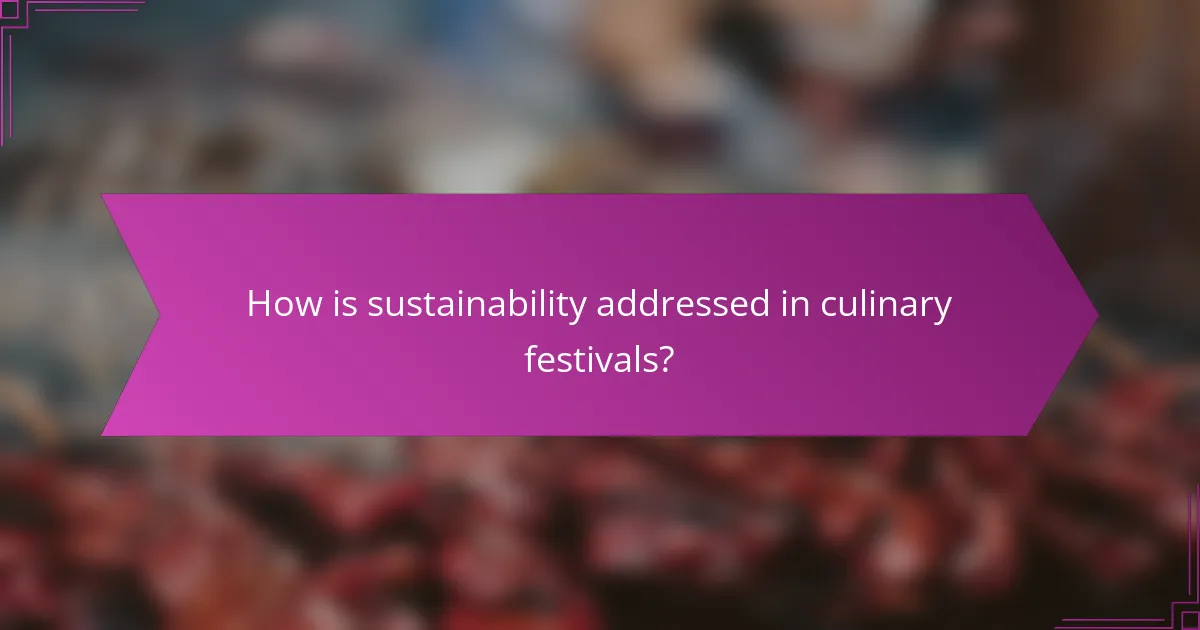
How is sustainability addressed in culinary festivals?
Sustainability in culinary festivals is addressed through local sourcing, waste reduction, and community engagement. Festivals in Italy often feature regional ingredients, promoting sustainable agriculture. For example, many events collaborate with local farmers to ensure fresh produce, reducing transportation emissions. Additionally, organizers implement waste management practices, such as composting and recycling, to minimize environmental impact. Community involvement fosters awareness of sustainability, encouraging attendees to support eco-friendly practices in their daily lives.
What practices promote local sourcing and waste reduction?
Culinary festivals in Italy promote local sourcing and waste reduction through community engagement and sustainable practices. Local farmers supply fresh ingredients, reducing transportation emissions and supporting regional economies. Festivals often incorporate educational workshops on food preservation and waste management, encouraging attendees to adopt sustainable habits. Additionally, many events implement composting and recycling initiatives, minimizing waste generated during the festivities.
How do festivals educate attendees about sustainable eating?
Culinary festivals in Italy educate attendees about sustainable eating by showcasing local ingredients and traditional cooking methods. These events promote awareness of food sourcing, seasonal produce, and reducing waste. Workshops often highlight sustainable practices, allowing participants to learn directly from chefs and farmers. As a result, attendees gain valuable insights into the cultural significance of sustainability in Italian cuisine.
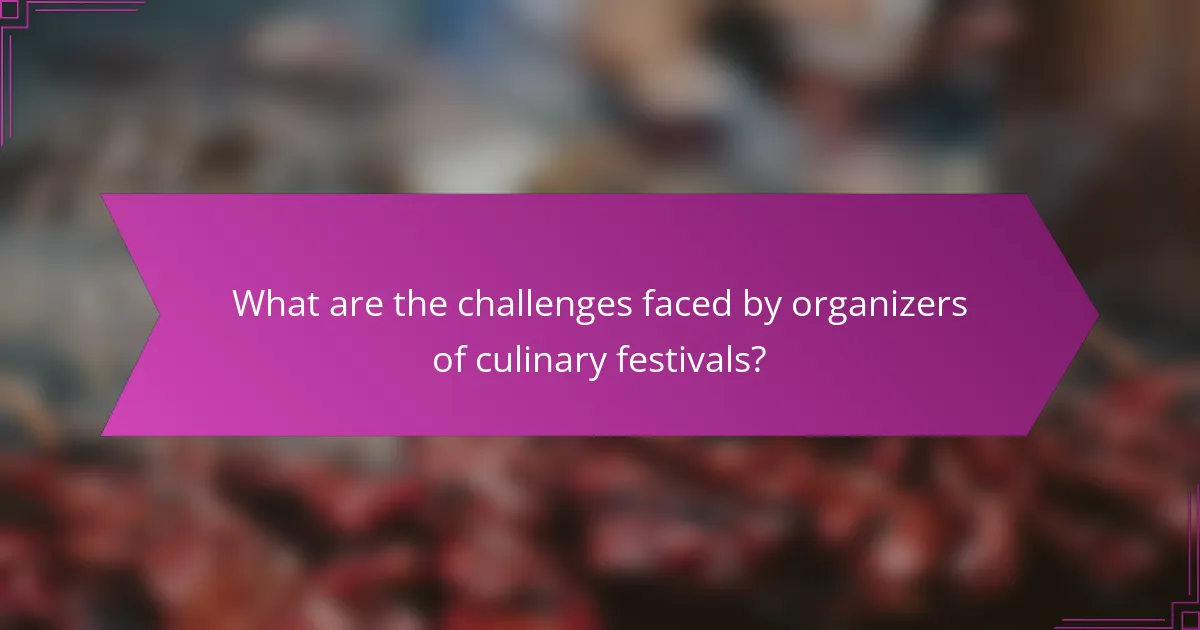
What are the challenges faced by organizers of culinary festivals?
Organizers of culinary festivals in Italy face several challenges, including logistical coordination, funding, and community engagement. Ensuring a diverse range of unique dishes while honoring cultural traditions can be difficult. Additionally, attracting and retaining participants requires effective marketing and planning. Weather conditions can also impact attendance and overall experience. Lastly, managing vendor relationships and compliance with health regulations adds complexity to the organization process.
How do economic factors impact festival planning and execution?
Economic factors significantly influence festival planning and execution by affecting budget allocation, sponsorship opportunities, and ticket pricing. Festivals in Italy, particularly culinary events, often rely on local economic conditions, which determine the availability of resources and funding.
For instance, a flourishing economy can lead to increased sponsorship from local businesses, enhancing the festival’s scale and promotional efforts. Conversely, economic downturns may result in reduced funding, limiting the types of unique dishes showcased and cultural traditions highlighted.
Additionally, ticket prices reflect economic conditions; higher prices during prosperous times can attract more tourists, while lower prices may be necessary during economic hardships to ensure community involvement. Such dynamics shape the overall experience and success of culinary festivals in Italy.
What strategies help overcome logistical issues?
To overcome logistical issues at culinary festivals in Italy, implement strategic planning, local partnerships, and effective communication.
First, ensure thorough preparation by assessing venue capacities, transportation options, and vendor requirements. Collaborating with local suppliers can streamline ingredient sourcing and reduce costs.
Establish clear communication channels among all stakeholders, including vendors, volunteers, and attendees. This fosters coordination and minimizes misunderstandings.
Lastly, utilize technology for ticketing and scheduling to enhance attendee experience and manage crowd flow effectively. These strategies can significantly improve the operational efficiency of culinary festivals.
What are common mistakes to avoid when attending culinary festivals?
To avoid common mistakes at culinary festivals, focus on preparation, timing, and engagement. Arriving unprepared can lead to missing out on unique dishes or experiences.
1. Failing to research the festival schedule can result in missing key events or tastings.
2. Not sampling a variety of dishes may limit your understanding of regional culinary traditions.
3. Overindulging too early can diminish your ability to enjoy later offerings.
4. Ignoring community involvement opportunities can reduce your connection to local culture.
5. Not asking questions about the dishes can hinder your appreciation of unique ingredients and preparation methods.
6. Forgetting to bring essentials like cash or reusable containers can complicate your experience.
What expert tips can enhance the festival experience for visitors?
To enhance the festival experience for visitors, focus on local culinary offerings, engage with community traditions, and participate in interactive activities.
1. Explore regional dishes to appreciate local flavors and culinary heritage.
2. Attend cooking demonstrations to learn traditional preparation methods.
3. Participate in community events to connect with locals and understand cultural significance.
4. Take part in guided food tours to discover hidden gems and local favorites.
5. Engage with chefs and vendors to gain insights into their culinary passions and stories.
6. Embrace the festive atmosphere by joining in on music and dance performances that celebrate local culture.
